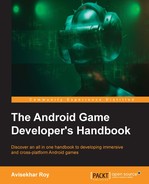In-game advertisements are the most significant factor in monetization for both free and freemium games. Developers use their game platform to show advertisements in order to generate revenue.
- Advertisers submit the advertisements to various advertisement agencies.
- Each advertisement has a certain value and time duration limitation, which is called campaign cost and campaign time, respectively.
- The developer subscribes with those agencies.
- The developer integrates the agency advertisement platform to include and show advertisements.
- The developer sets the parameters for advertisement types, genre, and level.
- When the application triggers an advertisement call to the agency server, it looks for the available or running advertisement campaigns that match the criteria predefined by the developer.
- Upon successful match, the server sends the advertisement elements to the client device application.
- The application loads the advertisements.
- The application shows the advertisements on request.
- The server keeps a count of successful display of advertisements and calculates revenue as per the campaign cost.
- The developer receives the revenue after meeting certain criteria from agencies.
Completely free games have no source of revenue other than advertisements or sponsorships. We will only look at advertisements here. Let's understand the requirement for advertisements inside a game.
We all work to earn our living. Android is an open source platform, and most of its user base consists of free users. This means developers have only one option left. Compared to other monetization aspects, advertisements are a good platform to depend on.
Advertising as an industry is old and has proven its sustainability in the market. In-game promotion is just another way to display advertisements. This way, it is always a win-win situation for both developers and advertisers.
Now, we will discuss typical game advertisement platforms. The developer needs to be familiar with a few terms to get used to in-game advertisement:
- eCPM
- CPC/CPA
- CPI
- RPM
- Fillrate
eCPM stands for effective cost per mile, which is the result of a calculation of advertisement revenue generated by a banner or campaign, divided by the number of ad impressions of that banner or campaign expressed in units of 1,000, which is represented by the letter M at the end.
CPC stands for cost per click, which means the developer will earn a certain amount if the user clicks on displayed advertisements. CPA stands for cost per action which is similar to CPC.
CPI stands for cost per impression, which means the developer will earn a certain amount if any advertisement is successfully displayed inside an application. Generally, these earnings are lower than CPC.
RPM stands for Revenue Per Mile. It indicates the total revenue generated from a thousand interstitial advertisements. RPM includes all types of revenue models. RPM is calculated by the following formula:
RPM = (Total revenue) / (Ads served / 1000)
Fillrate is the percentage of successfully served advertisements by the server. We already know that the application requests the advertisement server for advertisements. This is termed a "request." If a server successfully serves advertisements upon request, then the advertisement is termed an "impression". So we have our fillrate, as follows:
Fillrate = (Impressions/Requests)*100%
There are a few types of advertisement styles that can be used for Android games:
- Banner advertisements
- Interstitial advertisements
- Video advertisements
- In-game dynamic advertisements
Banner ads are generally ads with a continual display feature, which users cannot close or hide. However, there is a very low campaign value for CPI, but CPC is acceptable. Many developers nowadays avoid using banner ads, as it occupies a significant space of the game screen. Banner ads are displayed at a given rectangular shape at the edge of visible display.
Possible banner display positions are as follows:
- Top left
- Top center
- Top right
- Bottom left
- Bottom center
- Bottom right
The size variations as per the current scenario are shown in the following table:
An interstitial advertisement is a full-screen clickable image advertisement based on various campaigns. Normally, an interstitial has a defined close button for users to close the advertisement and go back to the game.
When an interstitial ad is shown, the ad view comes to the foreground, pushing the main game view to the background. So, each time the game thread triggers an interrupt for the game thread.
This type of advertisement is widely being used in games because of decent revenue. Game monetization design has a significant role in interstitial advertisements. Each advertisement placement has to be strategically based on the analytic data.
Integrating interstitial advertisements should follow a few logical ad displaying cycles:

It is always a good practice to follow the cycle. An ad should be loaded and be in ready state before being displayed. Upon closing an advertisement, the next ad should be loaded immediately to avoid load delay.
Video advertisements are one of the latest procedures to generate revenue. This type of advertisement has the maximum rate. However, the availability of video advertisements is comparatively less than image interstitial ads. There are two types of ads:
- Full length ads
- Short length ads
